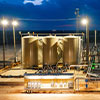
Trends Point To Robust A&D Activity
By Chris Atherton
HOUSTON–The U.S. acquisition and divestiture market suddenly has heated up, led by a number of headline-grabbing transactions in the Permian Basin, where nearly $22 billion in deals were announced during the first quarter of 2017. Buyers such as Diamondback Energy, Noble Energy, Parsley Energy, WPX Energy, PDC Energy, Callon Petroleum and ExxonMobil have invested significant capital in recent months to acquire or expand leaseholds in red-hot horizontal plays in the Midland and Delaware sub-basins, paying as much as $60,000 an acre.
Meantime, Continental Resources, Newfield Exploration, Marathon, Gulfport Energy, Jones Energy, Triumph Energy Partners and others have made moves in the SCOOP and STACK plays in Oklahoma, ranging from acquiring entire lease positions to purchasing smaller bolt-on acreage packages. In the Marcellus and Utica, operators such as EQT Corp., Rice Energy, Antero Resources and STL Resources have recently concluded acreage and asset acquisitions.
It should be noted that all of these resource plays also have seen significant regional deal activity in the midstream sector. In fact, the numbers and total valuations of deals in the midstream have equaled or exceeded those in the upstream sector for some basins over the past year.
What comes next for the A&D market? Will buyers and sellers continue to come together to make deals happen, or will activity slow in the second half of 2017? Several key trends have emerged that signal a continuation of robust activity throughout the remainder of this year and into 2018 for property deals valued in the range between $100,000 and $100 million.
In advising, facilitating, negotiating and closing hundreds of transactions in every U.S. basin, coupled with frequent interaction with both sellers and buyers, we see some important developments that are both shaping the A&D market and reflecting major changes in the makeup, focus and strategies of the upstream industry. For instance, private equity-sponsored management teams, which typically have a strategy to exit positions within three-five years, have made a mass exodus from the Permian over the past 18 months. Among those that have sold Midland and Delaware basin positions are Panther, Silver Hill, QStar, Silverback, CP Exploration II, Ameredev, Bold Energy, Double Eagle, Fortuna and Black Mountain.
Private equity-backed companies were a backstop for the industry during the downturn, committing new money for deployment when the market was down during the especially challenging days of late 2014 and all of 2015. With these companies opting to cash out as the Midland Basin, Delaware Basin, STACK and SCOOP have gotten hotter, the trend raises the question of what these companies do next: Get back into the most active basins or go elsewhere? With the big mass exodus of private equity-sponsored companies from the Permian, it will be interesting to see if the number of mergers increases, especially among public companies. Additional consolidation is likely.
Win-Win Deals
One of the more interesting deals in the Permian was Diamondback Energy’s $2.55 billion acquisition of Brigham Resources’ Delaware Basin position, giving Diamondback more than 76,000 net acres of leasehold interests and 182,000 net surface acres. Bud Brigham’s teams have continued to prove their wherewithal and have been rewarded accordingly, from successful runs in the Gulf Coast Basin, followed by the highly successful move to the Willison Basin and subsequent sale to Statoil. Brigham’s sale to Diamondback Energy is a win-win for both sides.
Brigham certainly got a good deal, but Diamondback did as well as the company looks to develop the leasehold acreage in a basin with a tremendous amount of upside. Diamondback can continue to develop the position and make a lot of money doing it.
An interesting topic of conversation amid A&D circles is who will make the next big acquisition in the Permian. Is another WPX Energy, PDC Energy, Diamondback, Parsley Energy or Noble Energy capable of doing a $1 billion-$2 billion transaction right now, or are they focusing solely on digesting what they have recently acquired? Speculation centers on whether the timing is right to go to market with a big Delaware or Midland basin package if all these big players are sidelined as they work to assimilate recent acquisitions.
Generally, there is ample access to capital in these lucrative basins, including $100 billion in dry powder from private equity groups and inflows of substantial capital from public stock offerings and Wall Street’s eagerness to back proven industry veterans in new ventures. There is a lot of public and general investor interest in the oil and gas sector right now. In addition to that, the companies that are making these acquisitions are doing it with their own stock without diluting shareholder value.
Former chief executives of large-cap, publicly traded companies are being handed blank checks by Wall Street to acquire assets. Centennial Resource Development, headed by former EOG CEO Mark Papa, Silver Run II overseen by former Anadarko CEO James Hackett, and Vantage Energy, managed by Roger Biemans formerly of Encana, and TPG Pace, managed by former Oxy CEO Stephen Chazen, are examples of emerging special-purpose acquisition companies that Wall Street has been eager to back.
Accomplished oil and gas managers who have retired or left larger companies used to raise private capital first and then identify and develop acreage. Now those executives are able to go to the public markets first and raise $1 billion or more from the outset. The market is so confident in their abilities that instead of getting a commitment from a private equity sponsor of $500 million, for example, and then building a team and buying assets, Wall Street is providing these special-purpose acquisition companies with large amounts of capital up front.
For example, the market provided about $1.8 billion to Papa that allowed Centennial Resource to acquire substantial assets in the Delaware Basin and become a public company from the outset. It is an interesting concept that these heavy-hitters are being rewarded for their past hard work and experience to go out and do it again. The trend will have a growing impact on A&D market dynamics.
Asset Trading
Asset trading in the hot basins is becoming much more prevalent. Previously, basin intelligence varied among operators in the conventional industry, but that has changed. For example, the land grab in the Delaware Basin, Midland Basin and SCOOP/STACK among larger publicly traded independents (including Parsley, Pioneer, Anadarko, Encana, Newfield and Cimarex) has allowed companies to acquire positions with the thought of trading some acreage to other companies to consolidate positions and put all their pieces of the acreage puzzle together.
One company may have a big block of acreage but has a puzzle piece that does not fit or see acreage somebody else owns that helps them complete its puzzle. The operating companies are trying to consolidate acreage in core areas to have contiguous blocks of leases they can develop with fewer encumbrances. In some cases, companies may even buy properties they know will be valuable to somebody else so they can use them for bargaining leverage in future trades. Making a strategic move here or there to pick up properties of interest to other companies can be a valuable negotiating chip as an operator works to assemble its own acreage position.
In other emerging trends, initial public stock offerings are happening again in the upstream and these companies can be expected to be more active and aggressive in the A&D market. Examples include IPOs for Vine Royalty, Kimbell Royalty Partners, Vantage Energy, Jagged Peak, Centennial, Blackstone, Indigo, Covey Park and Haymaker among others.
There is usually an arbitrage in what the public market valuation is on those companies and what their assets are trading for. If a company’s stock is trading at so much per net acre or so much per flowing barrel a day or so much per increment of reserves in the ground, acquisitions of assets that are at a discount to that trading value are immediately accretive to the stock price. If a stock is trading at $10 and those companies can acquire assets effectively discounted at $7, such an acquisition makes a lot of sense. Consequently, companies that are doing IPOs should become active players in A&D activity.
Diverse Food Chain
The food chain in the A&D business is much larger and more diverse now than most think. Conventional wisdom holds that small companies almost always sell assets to larger companies, but that is no longer necessarily the case. While that trend certainly continues, it goes both ways now. Large companies are selling big packages of assets to smaller companies that are just starting out or growing their portfolios. Instead of always assembling a team and organically building up assets and selling to larger companies, private equity companies are buying each other. We see a lot more dynamics in the food chain than conventional wisdom realizes. If each of the 20,000-plus qualified buyers in the market were major league baseball players, they would equal the number of every player who has ever played professional baseball.
In other developments, the vast majority of Chapter 11 restructuring work caused by the severe commodity price downturn that began in late 2014 is concluding. Samson, Ultra Petroleum, Halcon Resources, Goodrich, Sandridge, LINN, Energy XXI and Chaparral all have re-emerged from bankruptcy and are getting back to business, taking an increasingly active role in A&D markets.
Those companies have finished restructuring their balance sheets, likely raised new capital, and have new boards and management teams in place. For example, Joe Mills is now president and CEO of Samson and Douglas Brooks is heading Energy XXI. These companies are in the process of examining oil and gas properties to get back to business.
The major oil companies and large-cap independents are conducting large-scale portfolio rationalizations that will likely continue through the end of 2018. Decisions were made in 2015-16 to divest assets that would not make sense for these larger entities to own at $20 oil or $120 oil. Capital is being directed to the most impactful projects. Consequently, assets or positions in basins that do not meet the hurdles are candidates for divestment. After the land grab of the past 36 months, basin-dominant operators are beginning to shed their second- and third-tier acreage positions to concentrate capital on their core assets, leading to enormous buying opportunities for the rest of the market, including for smaller privately held independents.
Basin-dominant operators with an enormous amount of acreage and drilling locations have been going through the process of examining when they planned to develop properties, how much capital those projects required, and how much time development would take. Some wells may be scheduled to be drilled in 15 years or 30 years, basically providing little present value to those companies. As a result, we are seeing large companies continuing to rationalize their portfolios, divesting acreage that could have tremendous potential for other players.
Investment Strategies
While the Permian Basin and the SCOOP and STACK plays seem to dominate headlines, a wide-ranging set of investment strategies continues to exist in the oil patch. In order to obtain investment capital, companies must commit to specific strategies they believe will work and in which they have expertise. The most successful buyers are often laser-focused on a specific region such as the Powder River Basin, Denver-Julesburg Basin, Kansas, South Texas, East Texas or Mississippi, or a particular category of operating expertise such as producing minerals, nonoperated working interests, horizontal San Andres development, waterflood projects, etc.
The oil and gas food chain is massive and there is a misconception that only activities occurring in the hottest plays are the most economic, but all players raise debt or equity, including smaller companies that also raise funds from friends or family. Everyone has to have a strategy that provides a competitive advantage in their given area of activity. While some dominant basin players may focus on the high-potential Permian or SCOOP/STACK assets, others are finding advantages in developing properties or reworking conventional reservoirs on the Gulf Coast, Kansas, Alabama, East Texas and elsewhere.
In other developments, royalty and mineral A&D is vying for a bigger audience and a bigger stage. Publicly traded royalty companies are becoming more prevalent. Viper, Blackstone, Prairie Sky and Kimbell are publicly traded royalty companies, and more are likely on the way. Historically, A&D activity in the mineral and royalty space has always been active, but Wall Street is demonstrating a growing appreciation for the segment.
A high volume of deals trades hands each year, but the vast majority of these deals–99 percent of all deals transacted–are valued individually at less than $20 million. By their very nature, there are thousands of owners of mineral and royalty interests, and the value of each owner’s interest is relatively low. There are hundreds of companies that serve as royalty aggregators. Consolidating the royalty or mineral space is effectively the equivalent of consolidating the blades of grass in your front lawn. First, you typically have to cut one blade of grass at time because you have so many unique owners, and second, it seems more blades of grass always sprout up.
There always has been a large number of transactions in the U.S. A&D market that involve buying and selling royalties in what are relatively small transactions in the grand scheme of things. However, Wall Street now has a better understanding of the value of royalties and minerals and understands that those rights are long lived. This will continue to impact the A&D outlook for the segment of the market focused on deals sizes smaller than $100 million.
Given the dynamic nature of A&D, changing trends, and the pipeline of new business coming to the market, we fully expect 2017 and 2018 to be extremely active where buyers will have great opportunities to acquire solid, company-making assets.

CHRIS ATHERTON is president of EnergyNet Inc., an oil and gas asset acquisition and divestiture firm specializing in auction sales, sealed bid transactions and government lease sales. He has been part of the EnergyNet team since 2002. He has been actively involved as the firm has completed more than $2.9 billion in transactions, including sell-side mandates from thousands of exploration and production clients. Atherton leads a multidisciplinary team specializing in land, technical, business development, marketing, information technology and administration. He is chairman of the Houston Wildcatter’s Host Committee for the Texas Alliance, and previously served as chairman of the Society of Petroleum Engineers Gulf Coast section Business Development Study Group. Atherton holds a degree in business management and marketing from Texas State University.
For other great articles about exploration, drilling, completions and production, subscribe to The American Oil & Gas Reporter and bookmark www.aogr.com.















